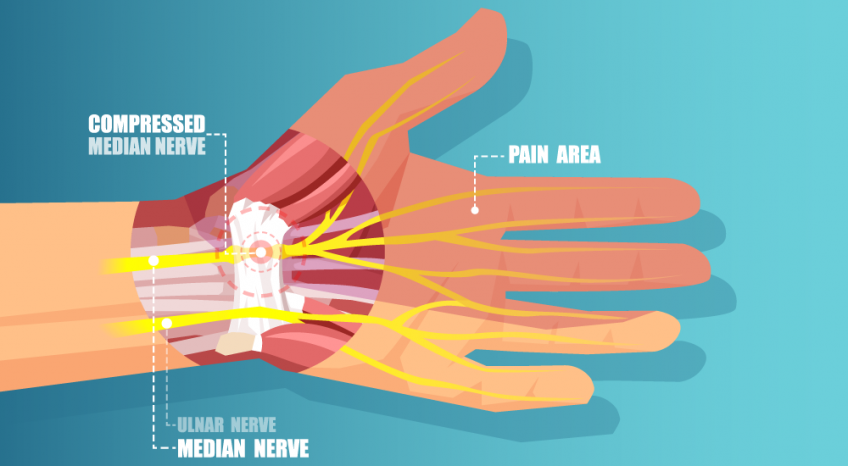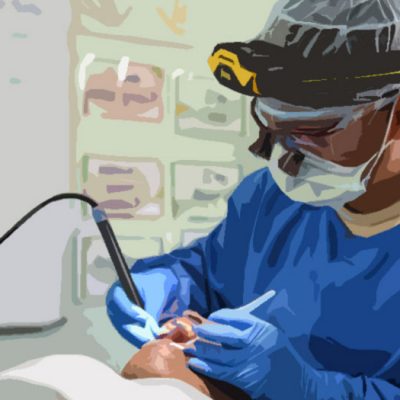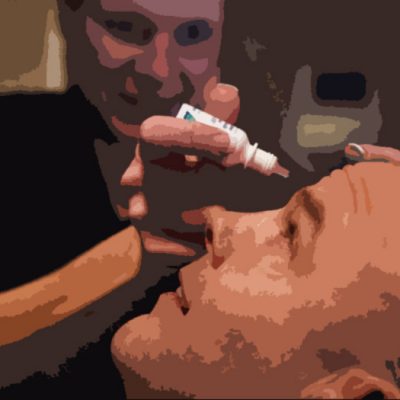The top 5 reported symptoms of Carpal Tunnel Syndrome (CTS), also known as median nerve compression, are as follows.
1. Numbness on the thumb-side of the hand
Sufferers often experience tingling or numbness — like pins and needles — up and down the thumb-side of the hand. The uncomfortable feeling — or lack of it — may extend from the thumb as far as the ring finger but is not felt in the little finger.
2. Weakness when trying to pick things up
Grip strength is reduced and, in particular, patients struggle to pick things up using their thumb. They may also struggle to make a fist and hold small objects.
3. Nerve pain in the wrist and hand
Nerve pain is commonly felt in the wrist or hand. Pain concentrated in the wrist can spread along the nerve up your arm or down to your fingers.
4. Waking up at night
The persistent nature of the numbness and pain from CTS often causes patients to feel pain at night. They may be awoken from their sleep and have trouble getting back to sleep.
5. Swelling and tenderness
In assessing whether a patient has CTS, the doctor will look for signs of swelling, tenderness and discolouration in the wrist and fingers that may be related to the condition arising.
Nature of the Condition
Every day, assembly line workers, keyboard operators and checkout operators experience repetitive microtrauma to their hands and wrists. What can result is a condition called carpal tunnel syndrome (CTS). With many of us spending considerable amounts of time at a computer, the incidence of CTS is high.
What is mostly affected is the major nerve controlling the thumb, index, and parts of the middle and ring fingers called the median nerve. This nerve travels from the tip of your fingers, through bones of your wrist, past your elbow, up your arm, through your shoulder and neck and finally to your spinal cord.
Wrist pain and numbness into the hand are the most common complaints. Because many are sitting long hours at the computer, neck pain is often described, as well.
Here are some common early warning signs:
- Numbing, tingling and burning in thumb and index, long and ring fingers.
- Symptoms often reported at night.
- Relief is reported when shaking or rubbing the hands.
- Hand weakness with reports of dropping things like a dish or cup of coffee.
Managing these problems conservatively often brings about a favourable outcome. As a chiropractor, in some of the more difficult cases, working with other clinicians such as an orthopedist or physical therapist can be helpful.
When symptoms first appear, CTS is more effectively treated with early intervention by a healthcare professional skilled in managing this type of condition.
Patient Symptom Examples
Jennifer Damian tried to ignore the tingling and numbness she felt in her hand after playing the drums for hours at a time.
Chalking it up as an occupational hazard, the 28-year-old professional percussionist refused to see a doctor, even after the tingling became a nightly ache. “I knew it was bad, but I thought I was being a wimp,” she said. Unfortunately, the problem got so much worse when she was pregnant that it now hurts to pick up her infant son.
Howard Egerman, 55, typed disability claims for the Social Security for a living. “My hand would go numb, and it would wake me up in the middle of the night,” recalls Mr Egerman.
Like Ms Damian, Mr Egerman ignored his symptoms at first. “I just tried to tough it out,” he said. Eventually, when the swelling and pain became too much, he saw a doctor and underwent surgery on both hands.
Classic Signs of CTS
Although the cause was different, both suffered the classic signs of carpal tunnel syndrome (CTS), according to Dr Edward Rankin, an orthopedic surgeon at Providence Hospital in Washington. “People with classic carpal tunnel syndrome complain of numbness, an inability to pick things up and waking up at night.”
Carpal tunnel syndrome is a specific wrist ailment that falls under the general category of repetitive-stress injuries. The carpal tunnel in the wrist is a small channel through which veins and the median nerve pass. CTS occurs when pressure is put on the channel, causing the nerve to become pinched.
Causes of the Pinched Nerve
The pressure that leads to CTS symptoms can be caused by repetitive, awkward movements that keep the wrist in a bent or twisted position.
Although typing on a computer keyboard has garnered the most attention as a trigger for wrist pain, CTS can result from a variety of movements. Assembly-line workers, tailors, pianists and chefs are all susceptible to the disorder, owing to the repetitive nature of their work. Gender also plays a part: women suffer from CTS at a rate three times their male counterparts.
If not treated, CTS can lead to permanent nerve damage. However, don’t panic if your wrist has been acting up lately. Not every wrist pain is an indication of CTS. Dr Rankin says wrist pain can be caused by a variety of factors, of which carpal tunnel syndrome is only one.
“The conditions that occur [from workplace activities] are probably not carpal tunnel in the classic sense,” Dr Rankin says. “People without carpal tunnel syndrome complain of more pain.”
So, how do you know for sure? CTS isn’t easy to diagnose, even for a doctor. But, one of the ways doctors can determine the presence of CTS is by administering a simple test. Patients are asked to place the tip of their thumb and small finger together while the doctor pushes on the thumb. Weakness is considered a positive sign for CTS.
CTS Treatment
Although Mr Egerman ended up having surgery on both his hands, Dr Rankin notes that surgery is a relatively rare treatment for wrist problems. “In people with work-related symptoms, surgery isn’t best,” he says. Changing, or eliminating, the problematic activity provides the best results.
Karen Jacobs, a clinical professor of occupational therapy at Boston University, concurs. It’s not the computer keyboard or the drum that causes carpal tunnel syndrome. It’s improper usage of them. “If you work at a computer, don’t sit in an awkward position for eight hours a day and then get up and say, ‘Oh, my wrist hurts,'” says Prof Jacobs.
Ms Damian believes that if she had been taught proper technique as a young student, she never would have developed the wrist problems to the extent she has now. “Drumming doesn’t cause injuries,” she says. “It’s incorrect playing.” And Mr Egerman says his wrist problems were exacerbated by hitting the space bar too hard on his keyboard.
To help you maintain good wrist health, follow these tips:
- “If you think you may be developing carpal tunnel, see your doctor, and speak to an occupational therapist,” says Prof Jacobs. They can help you look at your activities, spot the cause of the problem and help you correct it.
- Make sure you limit the time spent on any one activity. If you work at a computer, says Prof Jacobs, take a break every 20 to 30 minutes.
- Practice good ergonomics and seek out products that allow the wrist to remain in a neutral position during activity. When typing, your knees and elbows should roughly form right angles; your eyes should be level with the top of the computer screen.
- Don’t just treat the symptoms. Using splints and ice will not make the problem go away. “It may not be carpal tunnel,” says Dr Jacobs. “It may be a neck and shoulder problem, and you feel it in your wrists. You need a definitive diagnosis.”
- Flex those wrists. Exercises, including the “prayer stretch” (palms together, elbows out at a 90-degree angle in front of the chest), or flexing and rotating the wrists for 5 minutes can help prevent CTS. However, if you suspect that you have CTS, stretching is not recommended without first checking with your practitioner.
- Carpal tunnel patients who have tried massage, heat and ice, B6 vitamin therapy and yoga have had success.
- Cortisone shots, aspirin, ibuprofen and natural anti-inflammatories such as willow bark, tumeric and bromelain (the enzyme found in pineapple) — all have been shown to reduce pain and swelling. As always, be sure to consult with your practitioner before taking medicine or herbs.









